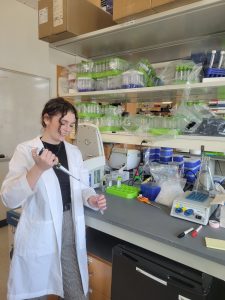Congratulations to our graduate student Sophia Campione, PhD for successfully defending her thesis titled “Understanding Systems-Level Oscillations: Comparative and Network Analysis of Dynamic Phenotypes” on March 18, 2024!



Congratulations to our graduate student Sophia Campione, PhD for successfully defending her thesis titled “Understanding Systems-Level Oscillations: Comparative and Network Analysis of Dynamic Phenotypes” on March 18, 2024!


New article in PNAS from Francis Motta and our group showing that the parasite’s intraerythrocytic cycle and the human host circadian cycle are coupled during malaria infection.
We provide direct evidence that the parasite’s intrinsic developmental cycle is aligned to the host’s circadian rhythm during malaria infection. This alignment suggests an evolutionary adaptation that creates synchrony between parasites during the blood phase and a method for evading host defenses or optimizing utilization of host resources that are controlled by the host circadian clock. This work opens the door for chronotherapeutic strategies for treating malaria infections.
See the PNAS paper.
Sophia Campione recently published an article in JOVE that allows for the alignment of synchronized time-series data using our previously developed CLOCCS model. This tool helps overcome a major challenge in analyzing synchronized time-series experiment, which is that the experiments can differ in the length of recovery from synchrony and the period. This means that measurements from different experiments cannot easily be analyzed together or compared. This tool allows for phase-specific and biologically relevant comparisons between experiments.
See the papers for the Alignment Tool and for the CLOCCS model.
In October of 2022 Steve Haase was elected as a Fellow of the AAAS in the Section on Biological Sciences. The AAAS describes AAAS Fellows as
a distinguished cadre of scientists, engineers and innovators who have been recognized for their achievements across disciplines, from research, teaching, and technology, to administration in academia, industry and government, to excellence in communicating and interpreting science to the public.
Steve Haase was recently featured in a video describing our work in the Syngerstic Discovery and Design (SD2) DARPA Program. This large collaboration focused on bringing experts together to study complex problems while creating a framework for scientific collaboration. This allowed for a 10-fold increase in the speed of an experimental cycle, while simultaneously increasing the complexity and accuracy.
“The SD2 program was designed in order to pursue these scientific endeavors much faster, must more accurately than we have in the past, by creating this interplay of technology and human capital.” – Dr. Jennifer Roberts
Steve Haase received the 2021 Dean’s Leadership Award for his work as part of Duke’s COVID-19 response team!
Steve is an essential member of the team that shaped Duke’s COVID-19 response and, in particular, organized and monitored our surveillance testing program, which at its peak included a dozen self-administered test sites serving undergraduate and graduate students, faculty and staff.
Before vaccines were available, the use of surveillance testing and rapid turnaround of test results was credited with keeping infections low.
The data produced at those sites – routed through Steve and his colleagues for analysis and modeling – was invaluable in guiding university decisions throughout the pandemic.
As an example, in June 2021 they elected to continue surveillance testing of students and the university community despite a significant decline in cases. At the time, Duke was the only university to do so, but with the arrival of Delta in September last year, many others followed suit – and quickly.
Welcome to our newest graduate student from the Program in Cell and Molecular Biology!
Robert Moseley and Sophia Campione recently developed a browser-based tool that allows for interactive visualization and generation of network models. The Inherent Dynamics Visualizer (IDV) connects to the network inference tool developed with our collaborators the Inherent Dynamics Pipeline (IDP). The IDV allows for informed decision-making on parameter choices made throughout the IDP. Together, the tools allow for streamlined inference of gene-regulatory networks.
See the papers for the IDV and the IDP. Watch the video for the IDV here:
The class taught this fall by Steve alongside Anna Christina Nelson was mentioned in the Duke Chronicle article ‘Seven Interesting Classes to Take in Fall 2022’!
“This course will examine the many rhythmic behaviors exhibited by organisms and cells, from sleep and wake cycles to flower openings to cell division and malaria infections. Classwork will center around the genetic and molecular networks that comprise clocks regulating cell division and circadian rhythms, as well as the quantitative aspects of clock networks through a data analysis and dynamical systems model perspective.” Alison Korn, Duke Chronicle
Full article here.
Congratulations to our graduate student Lauren Smith for successfully defending her thesis on March 29, 2022!

Powered by WordPress & Theme by Anders Norén